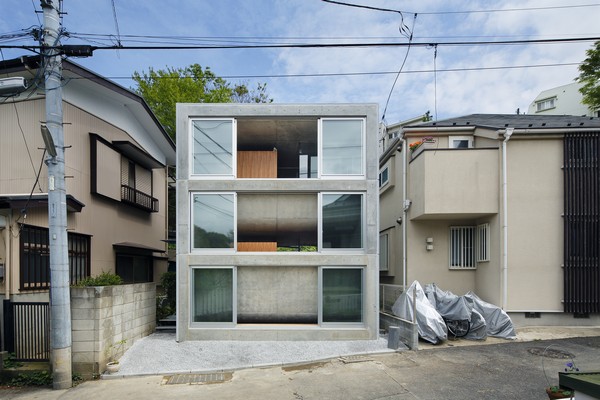
지하와 2개의 지상층으로 구성된 이 집은 구불구불한 언덕을 특징으로 하는 요코하마의 주거지역에 위치해 있다. 60평방미터의 부지는 남쪽과 북쪽의 집 사이에 끼어 있는 공간이며, 동쪽에는 3m 높이의 벽이 막고 있어 이 공간은 마치 주변 환경에 파묻혀있는 듯하다. 지하와 지상 모두에 빛과 바람이 잘 드는 방법을 찾아 설계하였는데, 모든 층은 같은 높이와 크기로 창문을 설치하기 위해 층마다 바닥은 집의 바깥쪽으로 조금씩 휘어져 있다. 콘크리트가 사용된 지하의 천장을 높여 집안으로 볕이 잘 들게 하고, 동쪽에 위치한 푸른 언덕에서는 특이한 형태로의 천장 끝 부분이 보이게 되어있다. 일 층에 비스듬히 올라가는 형태의 바닥은 거주자를 바깥의 시선으로부터 자유롭게 하고, 프라이버시를 지켜준다. 또한, 지하와 마찬가지로 채광과 통풍에 신경을 썼는데, 특히 1층 중심부에 위치한 화장실 천장에는 아크릴을 사용하여 자연광이 집의 중심부로 잘 들어올 수 있도록 하였다. 2층 바닥 역시 조금 기울어져 있어, 마치 밖의 언덕을 그대로 옮겨놓은 것처럼 보인다. 지붕 또한 약간 구부러져 있는데, 이것은 지붕에 난간이 없어 빗물이 창으로 흘러들어오지 않게 하기 위한 것이다.

A house with a basement and two floors above ground was planned in a residential area in Yokohama, which is characterized by rolling hills. The 60-square meter site is sandwiched by existing houses to the south and the north. On the east side, the site faces a 3m-tall retaining wall. In these ways, the site at first looked like it was buried by the surroundings.
In response, the design sought to pull in an equal amount of light and wind in section to both the basement and the ground level. Each floor was given the same ceiling height. The slab on each floor was bent near the exterior to give the same window size in section to each floor. In the basement, the ceiling of the concrete, which gradually rise, invites natural light to the interior. The green of the slope on the east side can be seen at the end of the rising ceiling.


On the first floor, the rising floor blocks view from the street and ensures privacy, while also inviting light and wind from outside. An acryl was used for the toilet's ceiling, located in the core furniture of the first floor, allowing natural light to enter even though it is placed at the center of the floor.


The second floor gradually slopes to provide a comfortable space as if to replicate the hills outside. The roof slab is also slightly bent. This was done to prevent the rainwater that collects on the parapet-less roof from flowing to the windows.

















0개의 댓글
댓글 정렬